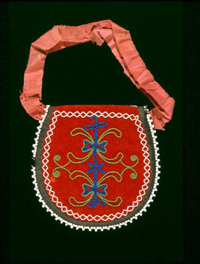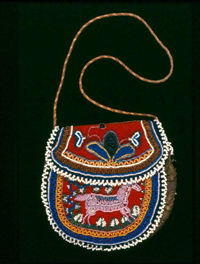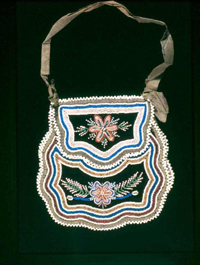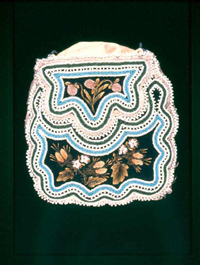Purses
By the early 1700s, the use of hides for clothing had given way to cloth, except for moccasins and pouches. All aspects of men’s and women’s attire – from head to foot – could be decorated with beadwork and ribbon appliqué. Seed beads were applied to red, dark blue or black wool fabric by running a needle and thread through them, and laying the strand of beads on top of the fabric along the lines of the desired design. Beaders then used a second needle and thread to stitch down the line of beads, every two to four beads. Line beadwork was often combined with brightly colored silk and satin ribbon appliqué patterns.
 |
Seneca-style purse, c.1840-1860Nancy & Roger Prince (NTP 2) |
Huron-style purse, c.1850
Nancy & Roger Prince (NTP 6) |
 |
Seneca-style, c.1870Nancy & Roger Prince (NTP 1) |
Tuscarora-style purse, c.1840-1850Nancy & Roger Prince (NTP 5) |
 |

 Moosehair embroidery combined with beadwork. The Urseline nuns in Quebec brought with them the European tradition of silk thread embroidery, which was adapted to New World circumstances with the substitution of dyed moosehair as embroidery floss. In the 1700s, they passed this technique on to Native women who drew on North American vegetation forms for their design inspiration.
Moosehair embroidery combined with beadwork. The Urseline nuns in Quebec brought with them the European tradition of silk thread embroidery, which was adapted to New World circumstances with the substitution of dyed moosehair as embroidery floss. In the 1700s, they passed this technique on to Native women who drew on North American vegetation forms for their design inspiration.